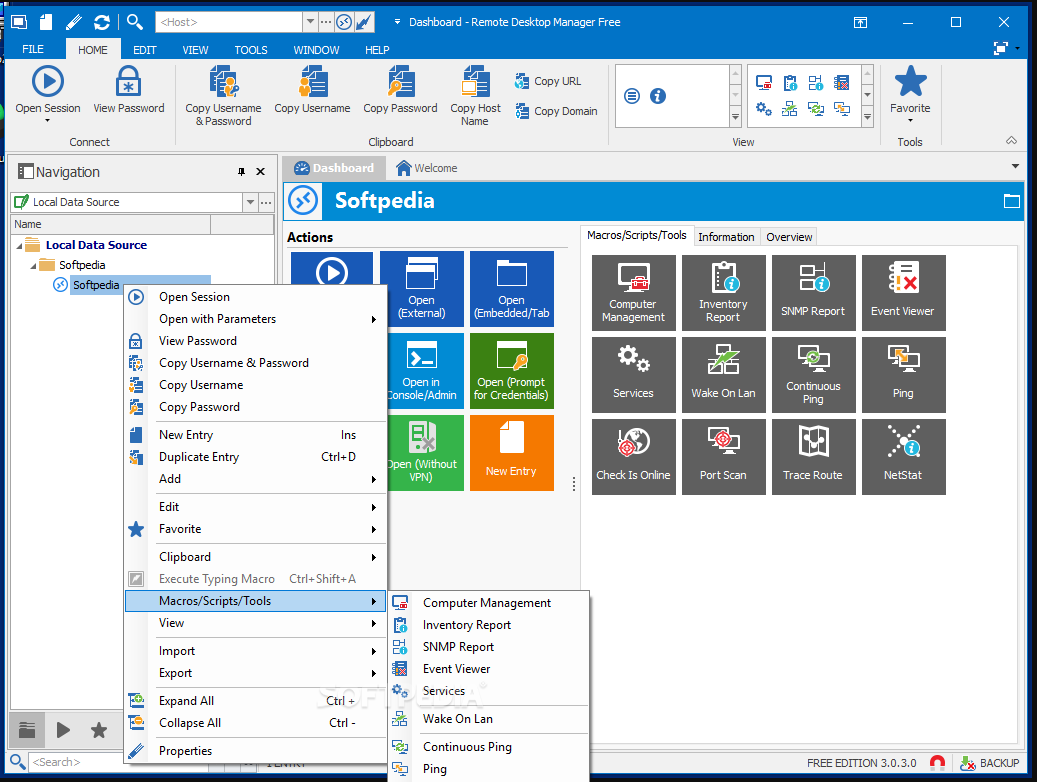- Remote Desktop Connection Manager Microsoft Windows 10 Download
- Remote Desktop Connection Manager Microsoft Download Windows 10
- Microsoft Remote Desktop Download
This article describes Remote Connection Manager (RCM) and the changes to RCM in Microsoft Windows Server 2016.
- Version 6.0 client is available for Windows XP SP2, Windows Server 2003 SP1/SP2 (x86 and x64 editions) and Windows XP Professional x64 Edition. Microsoft Remote Desktop Connection Client for Macintosh OS X is also available with support for Intel and PowerPC Mac OS versions 10.4.9 and greater. Server 2012 can support RDC 6.0 or later.
- Windows 7 SP1, 8.1 or 10; Windows Server 2008 SP2, 2008 R2 SP1, 2012, 2012 R2 or 2016; Microsoft.NET Framework 4.7.2; 1 Ghz processor; 512MB RAM; 1024 x 768 screen resolution; 500+ MB hard drive space; 64-bit Support. Remote Desktop Manager is compatible with all 64-bit versions of Windows, starting with Windows 7 SP1. Terminal Services.
In this article. Windows 10; Windows Server 2016; Introduced in Windows 10, version 1607, Windows Defender Remote Credential Guard helps you protect your credentials over a Remote Desktop connection by redirecting Kerberos requests back to the device that's requesting the connection. RDCMan is a client that is widely used to manage multiple remote desktop connections because it's a convenient option. However, RDCMan has not kept pace with the level of advanced technology that we're pursuing. Instead, we have two great supported client options.
Original product version: Windows Server 2016
Original KB number: 3200967
Changes to RCM
In Windows Server 2012 R2 and earlier versions, when a user logs on to a terminal server, the RCM contacts the domain controller (DC) to query the configurations that are specific to Remote Desktop on the user object in Active Directory Domain Services (AD DS). This information is displayed in the Remote Desktop Services Profile tab of the users object properties in the Active Directory Users and Computers MMC snap-in.
Starting in Windows Server 2016, RCM no longer queries the user object in AD DS. If you require RCM to query AD DS because you are using the Remote Desktop Services attributes, you must manually enable RCM. For more information about this by-design behavior in Windows Server 2016, see RCM behavior in Windows Server.
Additionally, consider the following scenario:
- You install Windows Server 2016 with the Remote Desktop Session Host role.
- You configure a local user account to start an application during logon. You do so by using the Local Users and Groups tool in Computer Management.
In this scenario, you expect the user to be presented with the application in the Remote Desktop Session only. However, by default in Remote Desktop Session Host (RDSH) in Windows Server, a full Remote Desktop Session is presented, and the application setup process in the profile doesn't start.
To revert to the earlier (pre-Windows Server 2016) behavior, here's what to do:
If the server has the RD Session Host Role installed, apply the following registry keys to enable the RCM legacy model. It triggers an Active Directory query to check for RDP profile settings:
- Path:
HKEY_LOCAL_MACHINESOFTWAREPoliciesMicrosoftWindows NTTerminal ServicesandHKEY_LOCAL_MACHINESYSTEMCurrentControlSetControlTerminal ServerWinStations<Winstation name> - Name: fQueryUserConfigFromDC
- Type: Reg_DWORD
- Value: 1 (Decimal)
Then, restart the Remote Desktop Service. If the server doesn't have the Remote Desktop Service role installed, you must set up an extra registry key:HKEY_LOCAL_MACHINESYSTEMCurrentControlSetControlTerminal Server

More information
When a user logs on to an RDSH server, the attributes on the Remote Desktop Services Profile tab of the users object properties in AD DS aren't applied to the user. The user's attributes aren't enforced, and everything is working as designed. So, no warning is generated, and no event is logged.
Remote Desktop Connection Manager Microsoft Windows 10 Download
For example, if you use the RDS attributes to specify a Remote Desktop roaming profile, users won't load that profile. They will use a local profile instead. In this situation, there are no error message or logged events. You can only know whether the user profile isn't the RDS roaming profile in one of the following ways:
Remote Desktop Connection Manager Microsoft Download Windows 10
- You notice that the desktop environment isn't the expected layout.
- You view the profile types in the system Control Panel applet.
:max_bytes(150000):strip_icc()/remote-utilities-582db7cd5f9b58d5b1381c1a.png)
Remote Desktop Services Profile tab in Active Directory Users and Computers:
User profiles in Control Panel > System > Advanced SystemSettings > User Profiles:
The attributes that you can set in the Active Directory Users and Computers MMC snap-in are as follows:
- Profile Path
- Home Folder
- Deny Logon to the RDSH server
Enable RCM in Windows Server
Important
Microsoft Remote Desktop Download
Follow the steps in this section carefully. Serious problems might occur if you modify the registry incorrectly. Before you modify it, back up the registry for restoration in case problems occur.
Use either of the following registry values to enable the behavior of RCM in Windows Servers 2012 R2 and earlier versions:
Registry key 1:
- Path:
HKEY_LOCAL_MACHINESOFTWAREPoliciesMicrosoftWindows NTTerminal Services - Name: fQueryUserConfigFromDC
- Type: Reg_DWORD
- Value: 1 (Decimal)
- Path:
Registry key 2:
- Path:
HKEY_LOCAL_MACHINESYSTEMCurrentControlSetControlTerminal ServerWinStations<Winstation Name> - Name: fQueryUserConfigFromDC
- Type: Reg_DWORD
- Value: 1 (Decimal)
- Path:
Note
The default value for <Winstation Name> is RDP-tcp. However, this value can be renamed.
RCM behavior in Windows Server
At each user logon, RCM does the following things:
- Query the Terminal Services registry key for the fQueryUserConfigFromDC value.
- If the value is found and set to 1, contact the DC to get the user configuration information.
- If the value is set to 0 or not present, query the
Winstationskey for the fQueryUserConfigFromDC value.
